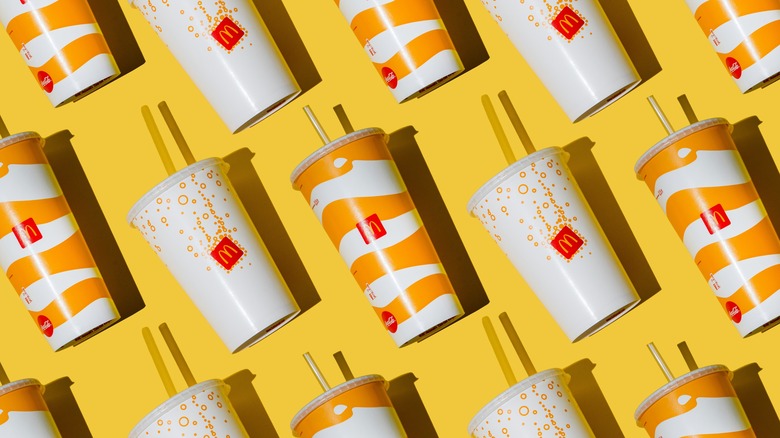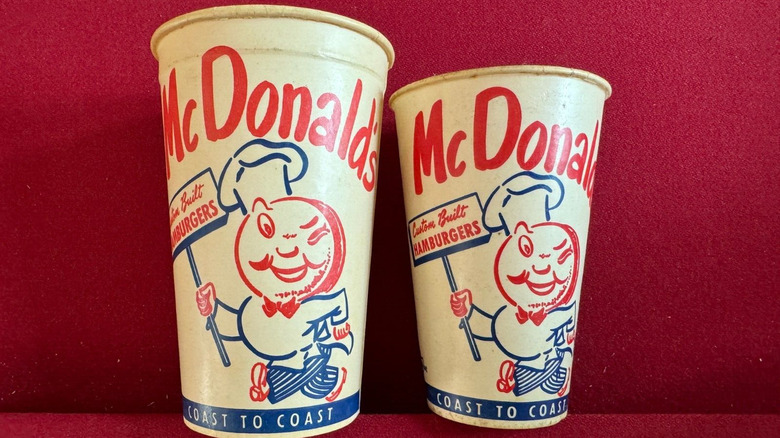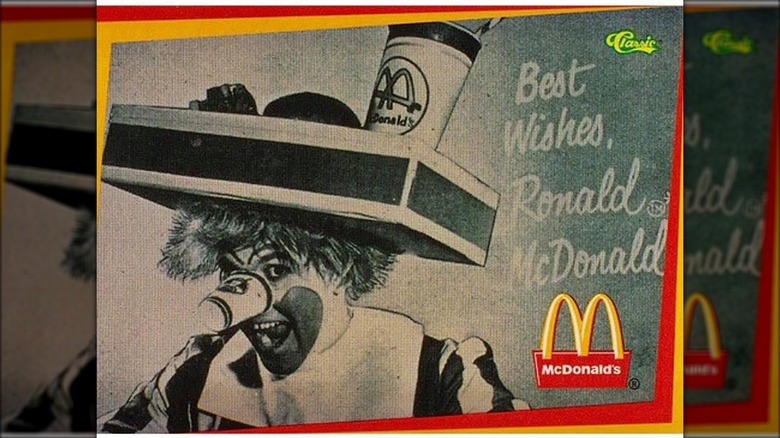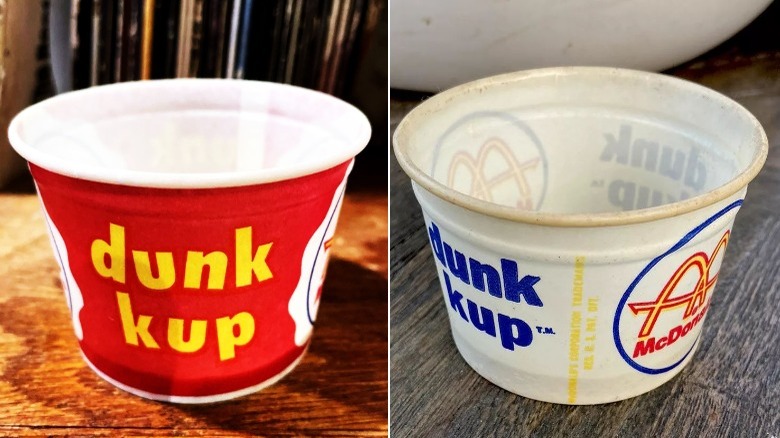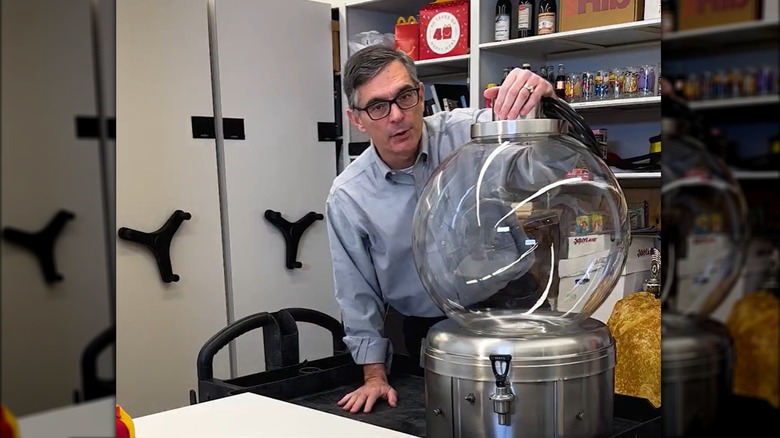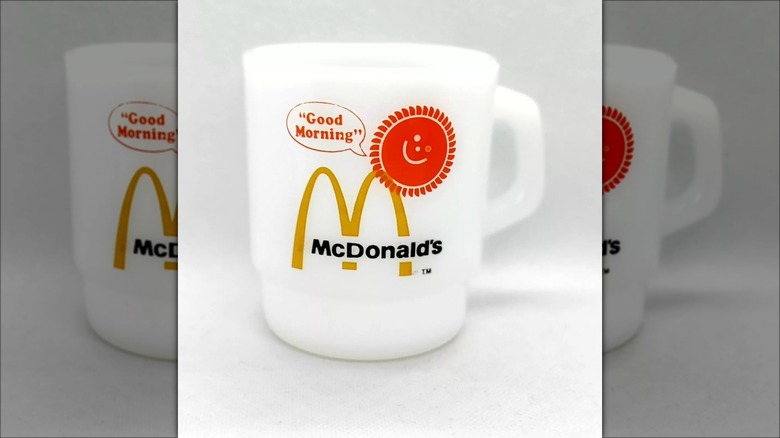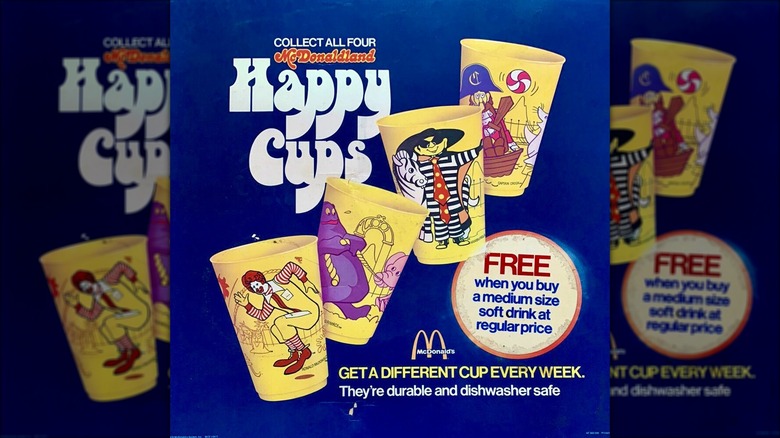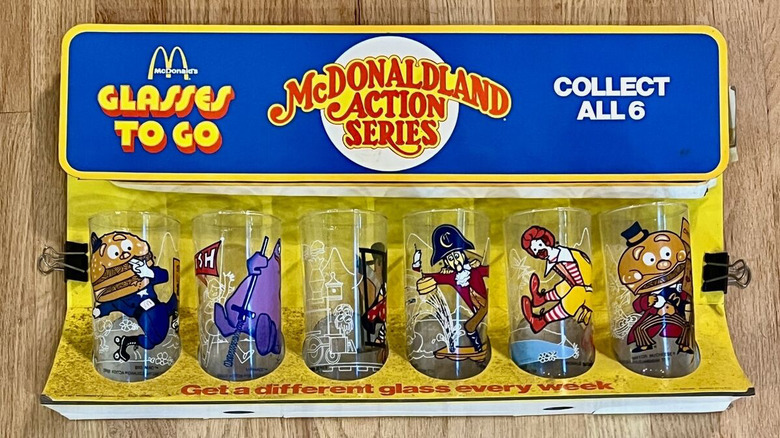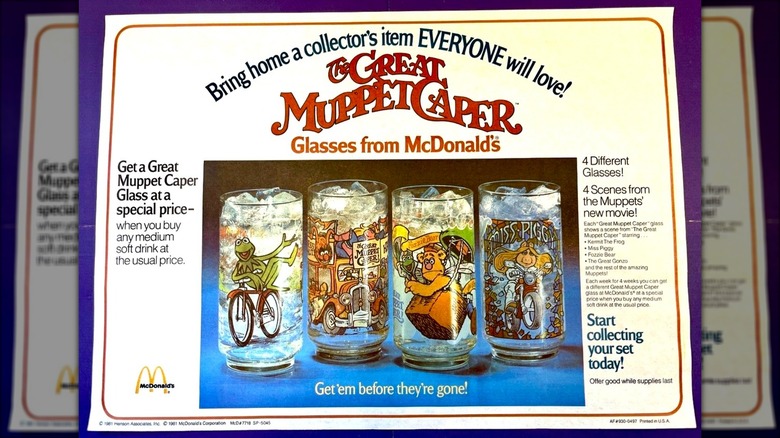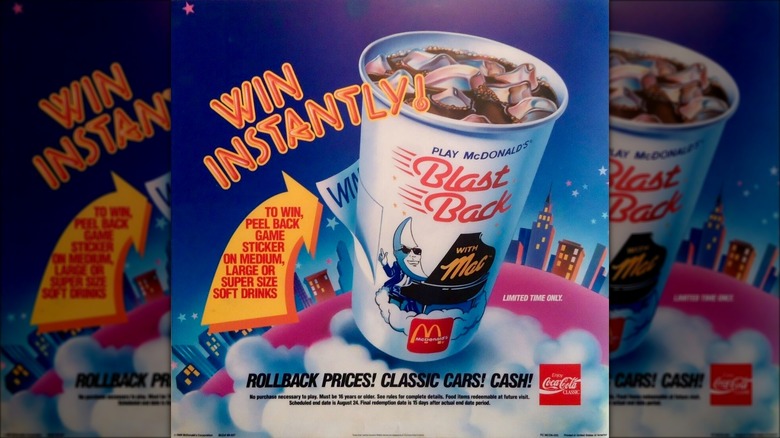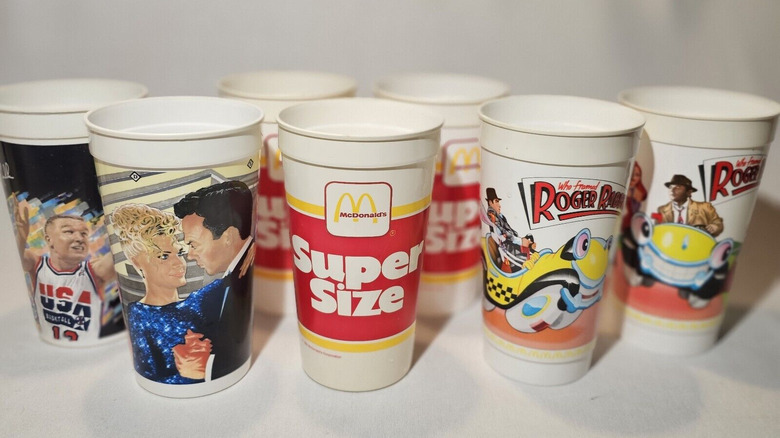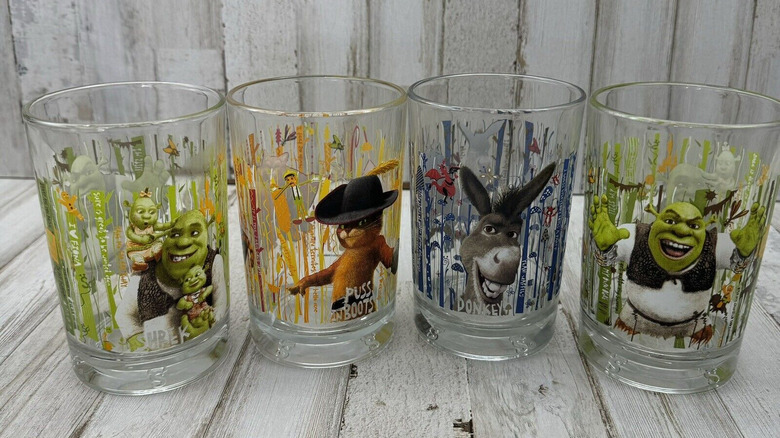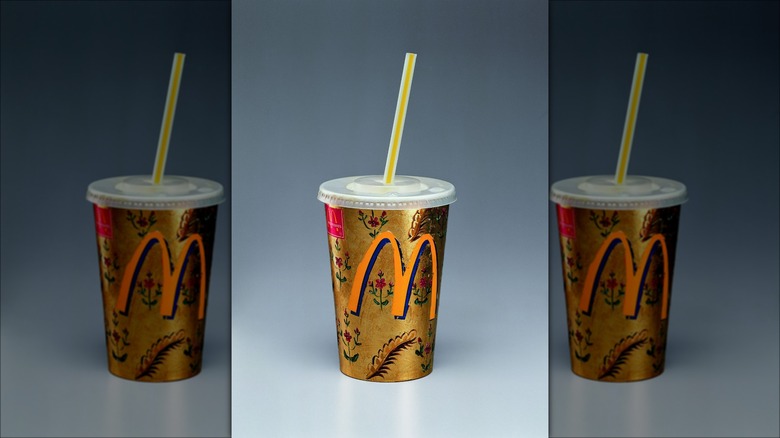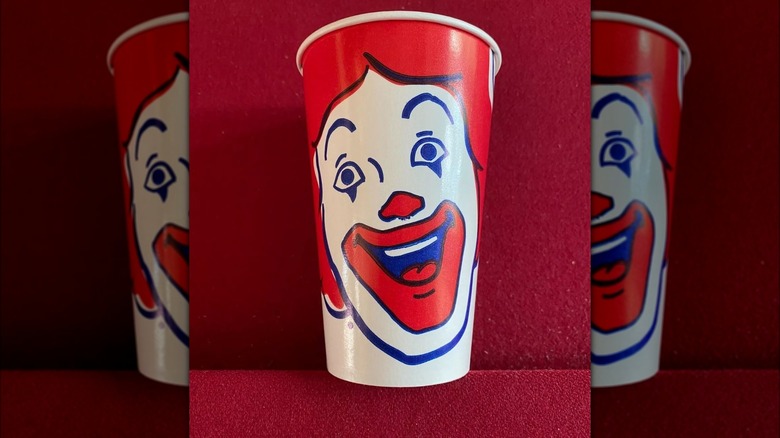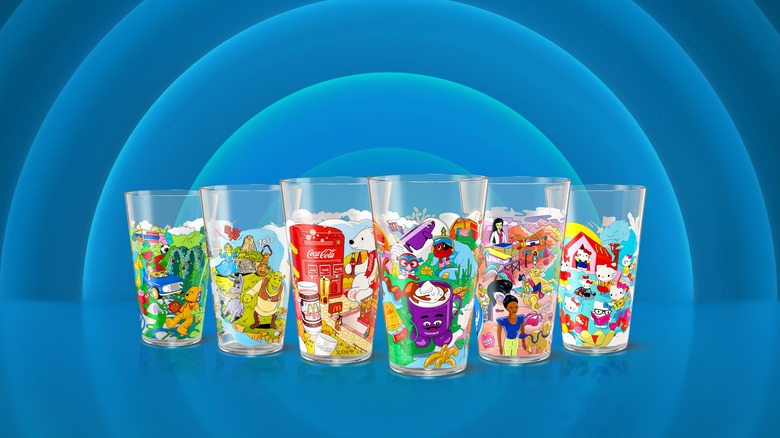14 Fun Facts About McDonald's Cups Throughout The Years
We may receive a commission on purchases made from links.
In 2024, McDonald's tapped into its fans' nostalgic love of collectible items from its past and released a set of six glasses with its Collector's Meal. Upon their launch, Daily Meal sat down with Mike Bullington, senior archives manager at McDonald's Corporation, to not only discuss these new glasses, but to also reminisce about McDonald's cups and glassware throughout the years. Bullington said, "As I like to say, everyone has a story about McDonald's, and by looking at these cups, it's going to rekindle memories. My job is to tell the story of McDonald's."
With the help of Bullington as the keeper, minder, and reminder of the company's vast trove of treasures, we dug deep to help tell the story of McDonald's, specifically through its cups and glassware. Here are all the fun facts you probably didn't know about these famous cups throughout the years.
1. The first McDonald's character to be featured on a cup was Speedee
By 1948, McDonald's perfected assembly line process was given the name "Speedee Service System." Along with it came the winking chef mascot, who appeared on the company's sign. By 1954, that mascot gained a fitting name — Speedee — which began to adorn bags, wrappers, containers, and wax paper cups.
When McDonald's shifted its message to "Look for the Golden Arches" in 1960, Speedee was phased out within two years and replaced by an arched, slanted "M" logo. According to former franchisee Bill Foshee, Speedee's demise was also precipitated to avoid confusion with stomach pain-reliever Alka-Seltzer's own mascot Speedy (via The Wichita Eagle). In 1963, McDonald's introduced a new, yet short-lived, mascot who appeared on cups — Archie McDonald.
While Speedee was no longer the official mascot, he can still be seen today at a few McDonald's locations across America. In 2021, lucky patrons in Japan were able to get a close-up of him once again on retro cups and packaging when McDonald's celebrated its 50th year in the country.
2. The original Ronald McDonald character wore a cup for a nose
Ronald McDonald has quite the evolution as a spokesclown through the years, and it all started back in Washington DC, with local TV personality Willard Scott. One of Scott's jobs was slipping into the role of Bozo the Clown for a kids' variety show. Washington advertising executive Barry Klein worked with the show, and with a local franchisee of McDonald's. Klein had the idea to have McDonald's advertise on the Bozo show, and then have Scott dress up as Bozo to make numerous appearances at McDonald's openings in the area.
When the Bozo show was canceled in 1963, Klein and Scott moved forward with a new clown to promote the hamburger chain, dubbed Ronald McDonald. Scott enlisted the help of a Mrs. Hubbard at Jack Mullane's costume shop to flesh out his look. That first costume included a McDonald's cup for a nose, and to top it off, a food tray for a hat.
McDonald's Corporation elevated Ronald as the new mascot for the entire chain. Michael "Coco" Polakovs was hired to replace Scott and give the clown a makeover. Polakovs replaced the head piece with a woman's red wig and ditched the cup nose in lieu of a red painted one.
3. Before McDonald's used ketchup packets, customers filled dunk kups with condiments
While today's McDonald's is a bastion of condiments and dipping sauces, that wasn't always the case. It took until 1963 for ketchup to even be offered as an option. In a print ad that appeared in the Kingsport News that year, it read: "Something new has been added... for the convenience of our customers. We now have available Catsup in Dunk Cups." The ad depicts a bottle of Hunt's catsup, and a price tag of 3 cents.
The official name of this ketchup holder was the "dunk kup," and it came in either a red or white 3-ounce cup. When the dunk kup was introduced, customers at some locations were given a coupon for a free kup with the purchase of french fries.
Heinz invented the portable ketchup packet in 1968, and soon after struck up an over 40-year partnership with McDonald's that spelled the end of the dunk kup. Lovebirds Sharon and Robert Kays' first date was at a McDonald's in 1965, and have celebrated their anniversary in similar style at McDonald's year after year. The Kays told the company in a letter, "We now bring a small bowl from home that resembles our original dunk cup. We still feed each other french fries as we talk of all the happenings of bygone years." (via The Belleville News-Democrat).
4. A giant glass bowl used to dispense orange drink at community events
McDonald's served an orange drink as far back as 1955. It was mixed together in a clear glass contraption called the Orange Bowl that measured about 30½" tall and 16" wide.
After Ray Kroc assumed ownership of McDonald's, he introduced the "Orange Bowl" program as a way of giving back to the community. The program allowed non-profits free use of a portable version of the bowl, cups, and ice. A nominal fee was to be paid for the orange drink syrup, and eventually powder. Schools, churches, and organizations would utilize the Orange Bowl as a way to fundraise or just give away courtesy cups of the drink at events. The Orange Bowl was also used as a way entice customers to come to for profit events and store openings. By the '80s, the Orange Bowl was replaced by a less cumbersome Igloo cooler, which was yellow and red and included the McDonald's logo.
5. Coffee has been served in all kinds of cups
Cups of coffee have been served at McDonald's since the very beginning. By the 1950s, ads proudly promoted the coffee's "steaming hot" temperature, and the brew was served in wax paper cups with butterfly handles.
When an expanded breakfast menu was introduced in the 1970s, and promotional items came into play, McDonald's started offering ceramic coffee mugs. One of the most personally memorable ones to Mike Bullington is the 1975 Anchor Hocking mug, which was adorned with a smiling sun saying "Good morning." He recalled, "We broke down my parents home in Arizona after they passed and they had that mug in there ... a lot of memories."
As more consumers were ordering their coffee on the go, McDonald's introduced insulated cups by 1982, and a year later, spill-proof versions with adhesive that could stick in a car. Glass mugs were also a common sight in the '80s, including a Pyrex version made by Corning. There were also promotional glass mugs featuring the 1984 Olympics, Garfield, and "RocDonalds" Flintstones.
Styrofoam replaced paper cups as the main holder of its super hot coffee for McDonald's. In 1990, the company said goodbye to foam clamshell packaging for its food, but it took until 2013 for it to ditch Styrofoam cups for those made of double-walled paper.
6. Before there was a Happy Meal, there was the Happy Cup
In the 1960s, McDonald's was advertising with the jingle, "McDonald's is our kind of place. It's such a happy place. Hap-hap-happy place." That happiness was carried into the following decade thanks to ad man Bob Bernstein. Bernstein recalled to The Kansas City Star in 2004, "I came up with the Fun Glass, they suggested I call it the Happy Cup, which showed Ronald McDonald with his Flying Hamburger. It was the first premium product ever created for the company."
The first yellow plastic Happy Cup landed in stores in 1970, and ads suggested that buyers could: "Put flowers in it, drink from it, carry candy in it, eat from it, talk to it." It was such a success that new Happy Cups, as well as Happy Plates, hit stores in the years that followed, featuring many of Ronald's bygone McDonaldland friends, such as Capt'n Crook and Mayor McCheese. While collectible character glasses arrived on the scene by '75, the plastic Happy Cups hung around until at least '79.
7. McDonaldland glasses from the '70s had lead concerns
Lead has long been a common element used in the creation of glassware, including glazes that help keep the color of art printed on the side deep and brilliant. This was the case with the glassware McDonald's launched with its McDonaldland "Glasses on the Go" promotion in 1975.
Massachusetts raised red flags with McDonald's character glasses in July of 1977, when testing revealed that 18 times the allowed amount of lead was detected in them. Concerns of children licking or gnawing the glassware prompted McDonald's to suspend sales, and thus were left with a stockpile of 10 million unused glasses. The glasses were produced by Libbey Glass, and in 1977, a spokesperson for the company told the AP, "In 48 years of using this method, manufacturers have produced billions of glasses and there has been no problem." They added, "There's never been an incident of anyone being harmed." Glasses wouldn't return to McDonald's stores until October 1979, with a limited-time run of McDonaldland Action Series.
8. The Great Muppet Caper was the first movie tie-in on a glass
While one of McDonald's earliest movie tie-ins was a 1979 Happy Meal branded as a "Star Trek Meal," it didn't get into the movie glasses game until two years later. Its first foray into the genre was to promote the release of 1981's "The Great Muppet Caper."
The four glasses depicted scenes from the film and were designed by artist Daryl Cagle. He reflected on Facebook in 2018, "I did lots of glassware for the Muppets, including this one which was the first McDonald's premium featuring non-McDonalds characters. The bus wrapping around the glass was fun, and took a little thought. They have poor registration when printing on glasses, so the vertical lines have to be thicker — takes some getting used to."
The Muppets kicked off an era for McDonald's that has yet to see an end of promotions on cups. The ensuing decades saw the likes of pop culture icons on glassware and cups, such as The Dukes of Hazzard, Space Jam, New Kids On The Block, and The Lego Movie.
9. Contests make McDonald's cups even more appealing
In 1989, McDonald's introduced a new novel way to acquire contest game pieces — by putting them on the sides of cups and french fry boxes. The first known game to feature them was Blast Back with Mac Tonight, where vintage cars, jukeboxes, and Disney World trips were just a peel away. Other games that followed included 1993's NFL Kickoff Payoff, 1996's twin bill of "When the USA wins you win," and the Disney Trivia Challenge.
Monopoly was one of the most popular games ever held at McDonald's and was introduced in 1987 with perforated game pieces. By 1995, the pieces were affixed to the sides of cups and fry boxes. After a scandal broke in 2001 about a six-year scam involving winning McDonald's game pieces, the chain slowed down on peelable contests.
One of the last iterations of peelable game pieces on cups in the U.S. was the McCafé Rewards Card, which launched in 2012. Those peel pieces were eventually phased and customers switched to earning rewards through McDonald's app. As of 2024, contests with game pieces on cups are still going strong at McDonald's in the UK, with names like "Winning Sips" and Monopoly "Power Peel".
10. Super-Size plastic cups rise in the 1980s
While McDonald's once offered 48-ounce pitchers of soda, it didn't truly join the big leagues of giant soda until May of 1987 when the limited-time-only "Super Size" line was introduced with 32-ounce drinks, 22-ounce shakes, and a larger french fries pouch. They were promoted as, "Just for summer, we've made them better by making them bigger. So the tastes you love will last even longer."
Super Size returned for the summer of 1988, and with such a larger canvas to work with on the cups, they started being used for tie-in advertising. First up was promoting "Who Framed Roger Rabbit?", and later on, supporting the USA Olympic team. The following summer booked Disney's "Honey I Shrunk The Kids" for collectible Super Size cups, and the promotions just kept on rolling from there. In 1992, "Batman Returns" cups were topped with lids that doubled as frisbees. For the release of "Jurassic Park," Super Size was temporarily renamed "Dino-Size." In 1994, McDonald's got around to making a catchy slogan for customers to recite at the register — "Just say 'Supersize it.'"
Morgan Spurlock opened a lot of eyes, and harmed his own body in the process, by eating nothing but McDonald's for a month in his searing 2004 documentary "Super Size Me." Although the chain claims the film had nothing to do with the move, that same year, McDonald's phased out its Super Size line.
11. McDonald's recalls Shrek glasses due to high levels of cadmium
To help promote "Shrek Forever After," McDonald's released a set of four character glasses in 2010. They were advertised with the tagline, "There are two sides to every story," and for the story of these glasses, they didn't have a happy ending.
The promotion began on May 21, and by June 4, the company had issued a voluntary recall. Turns out, the artwork's paint had low levels of cadmium in it, which could end up being rubbed off onto a drinker's hand. The U.S. Consumer Product Safety Commission brought this to McDonald's attention, and while the glasses were deemed to not be dangerous for children or toxic in any way, the company acted quickly out of an abundance of caution.
While the glasses sold for as low as $1.99, McDonald's paid customers $3 for each one that was returned, making it more enticing for one to do so. It had 12 million glasses produced, and by the time the recall was in effect, 7.5 million had been sold. Hugh Morrow, a consultant for the International Cadmium Association, told The New York Times, "To me the whole thing about the McDonald's glasses is very much a mystery, and why they would be putting cadmium pigments in there." He added, "Our position is that cadmium pigments should not be painted on consumer glasses."
12. One McDonald's cup art had a $9,000 price tag
In 2013, a McDonald's soda cup made headlines when one was being sold for $9,000. However, this wasn't any ordinary cup, but a fancy golden one made by Guatemalan artist Darío Escobar. Escobar created his first one in 1998, using cardboard, plastic, gold leaf, and various pigments in a Guatemalan baroque technique to put it together. He would go on to make several more versions of the cup, which have found their ways into several museums and private collections across the globe.
In an interview with Daily Meal, Escobar explained, "I come from a country where it [McDonald's] is very popular and I always thought about the relationship between the food chain and Guatemala, finding an answer from more complex readings." The inspiration behind the cup pieces were inspired "to establish a connection between the past and the present, trying to explain from this object a relationship of co-dependence towards consumption."
13. A McDonald's Paper Cup resides in the Smithsonian's collection
The Smithsonian Institution is commonly referred to as the "Nation's Attic," holding such national treasures as the Star Spangled Banner flag, Dorothy's rubber slippers, and Archie Bunker's chair. Since McDonald's is very much an important piece of the fabric of Americana, it's no surprise that many items from the Golden Arches have been deemed worthy of being a part of The Smithsonian.
A majority of McDonald's paraphernalia is housed within the collection of National Museum of American History, and includes a wide array of items, including uniforms, clamshell containers, a hamburger yo-yo, and a Japanese McDonald's sign made in America. Its collection also includes one of the adhesive McDonald's travel mugs from 1983, as well as a single paper cup, complete with a plastic lid. While The Smithsonian could have had its pick of McDonald's cups from any era, the one it holds for safekeeping was a late 20th century cup featuring a cartoony close-up of Ronald McDonald's face.
14. 2024's Collector's Cups feature nods to cups past
In August of 2024, McDonald's released a new set of six cups, highlighting 53 collector's items from the 1970s-on. Bullington helped the design team research these items, but admitted he hadn't come across many of them in the archives. His favorite of the 53 reverences was a Hot Wheels ramp, which he said, "...reminded me of playing Hot Wheels in my parents basement with my younger brother."
Also, in a first for McDonald's, the cups reference other McDonald's cups that came before them. Bullington's most beloved McDonaldland character is Grimace, and two pieces featuring him were included – a 1976 mug, complete with his grounding purple feet, and a 1977 glass featuring his likeness. One Collector's Meal cup is a love letter to all things Coca-Cola, calling attention to not only the classic flared drinking glass from the soda company, but also a co-branded McDonald's version that resembled Tiffany stained-glass, which sold in Canada. Other cups and glassware refences within these six new cubs included Dino-sized Jurassic Park plastic cups, the Charles M. Shulz designed "Camp Snoopy" glasses sold in 1983,and a Changeables Transformer-like toy from 1987, which naturally featured a cup that turned into a robot.
